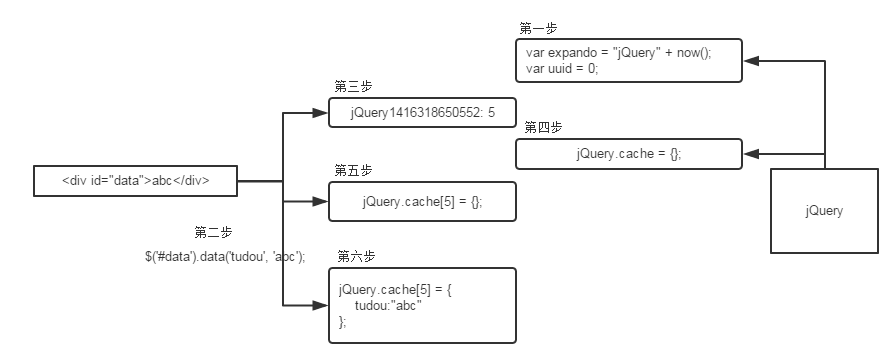jQuery剥皮三- data、proxy、event
jquery1.4 jquery1.4下载
这里使用了 jQuery1.4,为什么使用 1.4 因为 1.4 很多特性没有添加分析起来相对容易。
这个 data 的实现是扩展在 jQuery 静态函数里面的,我们平常这样( $(‘#data‘).data(‘tudou‘, ‘abc‘) )调用的是 jQuery 原型上的 data ,原型上面的 data 再调用下面 jQuery 静态的 data 方法实现。
jQuery.extend({
cache: {},
expando:expando,
// The following elements throw uncatchable exceptions if you
// attempt to add expando properties to them.
noData: {
"embed": true,
"object": true,
"applet": true
},
data: function( elem, name, data ) {
// 不是正确的元素过滤掉
if ( elem.nodeName && jQuery.noData[elem.nodeName.toLowerCase()] ) {
return;
}
elem = elem == window ?
windowData :
elem;
var id = elem[ expando ], cache = jQuery.cache, thisCache;
// Handle the case where there‘s no name immediately
// 没有 data 名 且 也没有设置过 data 返回
if ( !name && !id ) {
return null;
}
// Compute a unique ID for the element
if ( !id ) {
id = ++uuid;
}
// Avoid generating a new cache unless none exists and we
// want to manipulate it.
if ( typeof name === "object" ) {
elem[ expando ] = id;
// 如果传递过来的是对象,直接扩展到 cache 对象中
thisCache = cache[ id ] = jQuery.extend(true, {}, name);
} else if ( cache[ id ] ) {
// 如果有存储过,则拿到以前的
thisCache = cache[ id ];
} else if ( typeof data === "undefined" ) {
thisCache = emptyObject;
} else {
// 第一次存储,要新建一个空对象
thisCache = cache[ id ] = {};
}
// Prevent overriding the named cache with undefined values
// 把数据写入 cache 存储 根据uuid
if ( data !== undefined ) {
elem[ expando ] = id;
thisCache[ name ] = data;
}
// 返回附加的数据
return typeof name === "string" ? thisCache[ name ] : thisCache;
},
removeData: function( elem, name ) {
if ( elem.nodeName && jQuery.noData[elem.nodeName.toLowerCase()] ) {
return;
}
elem = elem == window ?
windowData :
elem;
var id = elem[ expando ], cache = jQuery.cache, thisCache = cache[ id ];
// If we want to remove a specific section of the element‘s data
if ( name ) {
if ( thisCache ) {
// Remove the section of cache data
delete thisCache[ name ];
// If we‘ve removed all the data, remove the element‘s cache
if ( jQuery.isEmptyObject(thisCache) ) {
jQuery.removeData( elem );
}
}
// Otherwise, we want to remove all of the element‘s data
} else {
// Clean up the element expando
try {
delete elem[ expando ];
} catch( e ) {
// IE has trouble directly removing the expando
// but it‘s ok with using removeAttribute
if ( elem.removeAttribute ) {
elem.removeAttribute( expando );
}
}
// Completely remove the data cache
delete cache[ id ];
}
}
});
这个 data 的实现是在 jQuery 函数上创建了一个静态变量 cache 对象,key 就是 data 的 name, value 就是 data 的 value。如下图:

现在来看一张图,来观察 data 实现的方法

实现方法就是 jQuery 在对元素操作的时候会赋值一个 "jQuery" + now() 时间戳的属性,其值是一个 uuid 唯一的数字,每次操作会加 1 ,然后在 jQuery 的 cache 的对象静态变量中根据这个 uuid 赋值一个 key 就像这样 {5:{}}。并且把你要加入的 data 放去这个 key 为 5 的对象中 {5:{tudou:"abc"}}。他们唯一关联的就是这个 uuid 。
看看 jQuery 的原型实现
jQuery.fn.extend({
data: function( key, value ) {
if ( typeof key === "undefined" && this.length ) {
return jQuery.data( this[0] );
} else if ( typeof key === "object" ) {
// 对象直接进行 data 存储
return this.each(function() {
jQuery.data( this, key );
});
}
var parts = key.split(".");
parts[1] = parts[1] ? "." + parts[1] : "";
// 如果只传 name 就是获取值
if ( value === undefined ) {
// 设置会触发 getData 自定义方法 他们都可以通过 bind 捕获
var data = this.triggerHandler("getData" + parts[1] + "!", [parts[0]]);
if ( data === undefined && this.length ) {
data = jQuery.data( this[0], key );
}
return data === undefined && parts[1] ?
this.data( parts[0] ) :
data;
} else {
// 设置值会触发 setData 方法 他们都可以通过 bind 捕获
return this.trigger("setData" + parts[1] + "!", [parts[0], value]).each(function() {
jQuery.data( this, key, value );
});
}
},
removeData: function( key ) {
return this.each(function() {
jQuery.removeData( this, key );
});
}
});
这里的实现就显得轻松许多了,只需要多 参数、获取/设置 值进行处理就可以了 ,然后去调用对应的 jQuery.data 方法去实现值的设置或者获取
之前简单的模拟过一个 原理差不多是这样
proxy 比较简单,但是很容易晕的一个东西,给你来几个 proxy + 返回闭包 基本都会晕 :(
proxy: function( fn, proxy, thisObject ) {
if ( arguments.length === 2 ) {
if ( typeof proxy === "string" ) { // 第一种方式调用方式 $.proxy(obj, ‘fn‘)
thisObject = fn;
fn = thisObject[ proxy ];
proxy = undefined;
} else if ( proxy && !jQuery.isFunction( proxy ) ) { // 第二种调用方式 $.proxy(obj.fn, obj)
thisObject = proxy;
proxy = undefined;
}
}
if ( !proxy && fn ) {
/*
* 返回重构好 this 的函数, 那么这里的 thisObject 是指向了最终 this 要指向的地方
*/
proxy = function() {
return fn.apply( thisObject || this, arguments );
};
}
// Set the guid of unique handler to the same of original handler, so it can be removed
if ( fn ) {
proxy.guid = fn.guid = fn.guid || proxy.guid || jQuery.guid++;
}
// So proxy can be declared as an argument
return proxy;
}
值得关注的就是 这个 thisObject 因为 js 中 函数、对象、数组是传址的,所以 thisObject 能指向你要代理到那个对象的 this 中。感觉非常绕,但是搞明白也就没啥了。随便说下 thisObject 肯定是一个闭包了
var obj = {
name: ‘tudousi‘,
test: function() {
alert( this.name );
return false;
}
};
var func = $.proxy(obj, ‘test‘);
$(‘.show‘).click(func);
郑重声明:本站内容如果来自互联网及其他传播媒体,其版权均属原媒体及文章作者所有。转载目的在于传递更多信息及用于网络分享,并不代表本站赞同其观点和对其真实性负责,也不构成任何其他建议。





































